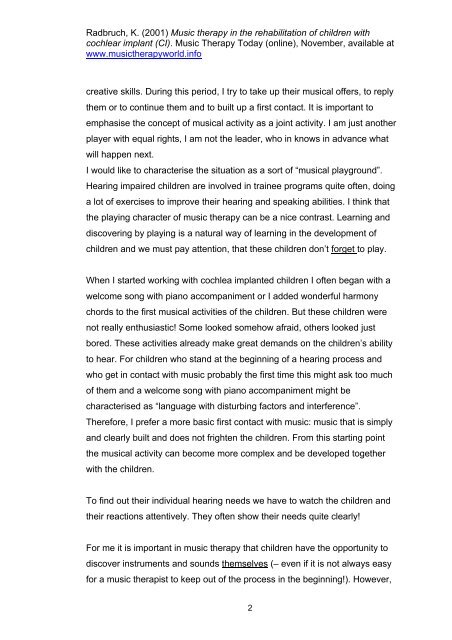Music therapy in the rehabilitation of children - World Federation of ...
Music therapy in the rehabilitation of children - World Federation of ...
Music therapy in the rehabilitation of children - World Federation of ...
Create successful ePaper yourself
Turn your PDF publications into a flip-book with our unique Google optimized e-Paper software.
Radbruch, K. (2001) <strong>Music</strong> <strong><strong>the</strong>rapy</strong> <strong>in</strong> <strong>the</strong> <strong>rehabilitation</strong> <strong>of</strong> <strong>children</strong> with<br />
cochlear implant (CI). <strong>Music</strong> Therapy Today (onl<strong>in</strong>e), November, available at<br />
www.music<strong><strong>the</strong>rapy</strong>world.<strong>in</strong>fo<br />
creative skills. Dur<strong>in</strong>g this period, I try to take up <strong>the</strong>ir musical <strong>of</strong>fers, to reply<br />
<strong>the</strong>m or to cont<strong>in</strong>ue <strong>the</strong>m and to built up a first contact. It is important to<br />
emphasise <strong>the</strong> concept <strong>of</strong> musical activity as a jo<strong>in</strong>t activity. I am just ano<strong>the</strong>r<br />
player with equal rights, I am not <strong>the</strong> leader, who <strong>in</strong> knows <strong>in</strong> advance what<br />
will happen next.<br />
I would like to characterise <strong>the</strong> situation as a sort <strong>of</strong> “musical playground”.<br />
Hear<strong>in</strong>g impaired <strong>children</strong> are <strong>in</strong>volved <strong>in</strong> tra<strong>in</strong>ee programs quite <strong>of</strong>ten, do<strong>in</strong>g<br />
a lot <strong>of</strong> exercises to improve <strong>the</strong>ir hear<strong>in</strong>g and speak<strong>in</strong>g abilities. I th<strong>in</strong>k that<br />
<strong>the</strong> play<strong>in</strong>g character <strong>of</strong> music <strong><strong>the</strong>rapy</strong> can be a nice contrast. Learn<strong>in</strong>g and<br />
discover<strong>in</strong>g by play<strong>in</strong>g is a natural way <strong>of</strong> learn<strong>in</strong>g <strong>in</strong> <strong>the</strong> development <strong>of</strong><br />
<strong>children</strong> and we must pay attention, that <strong>the</strong>se <strong>children</strong> don’t forget to play.<br />
When I started work<strong>in</strong>g with cochlea implanted <strong>children</strong> I <strong>of</strong>ten began with a<br />
welcome song with piano accompaniment or I added wonderful harmony<br />
chords to <strong>the</strong> first musical activities <strong>of</strong> <strong>the</strong> <strong>children</strong>. But <strong>the</strong>se <strong>children</strong> were<br />
not really enthusiastic! Some looked somehow afraid, o<strong>the</strong>rs looked just<br />
bored. These activities already make great demands on <strong>the</strong> <strong>children</strong>’s ability<br />
to hear. For <strong>children</strong> who stand at <strong>the</strong> beg<strong>in</strong>n<strong>in</strong>g <strong>of</strong> a hear<strong>in</strong>g process and<br />
who get <strong>in</strong> contact with music probably <strong>the</strong> first time this might ask too much<br />
<strong>of</strong> <strong>the</strong>m and a welcome song with piano accompaniment might be<br />
characterised as “language with disturb<strong>in</strong>g factors and <strong>in</strong>terference”.<br />
Therefore, I prefer a more basic first contact with music: music that is simply<br />
and clearly built and does not frighten <strong>the</strong> <strong>children</strong>. From this start<strong>in</strong>g po<strong>in</strong>t<br />
<strong>the</strong> musical activity can become more complex and be developed toge<strong>the</strong>r<br />
with <strong>the</strong> <strong>children</strong>.<br />
To f<strong>in</strong>d out <strong>the</strong>ir <strong>in</strong>dividual hear<strong>in</strong>g needs we have to watch <strong>the</strong> <strong>children</strong> and<br />
<strong>the</strong>ir reactions attentively. They <strong>of</strong>ten show <strong>the</strong>ir needs quite clearly!<br />
For me it is important <strong>in</strong> music <strong><strong>the</strong>rapy</strong> that <strong>children</strong> have <strong>the</strong> opportunity to<br />
discover <strong>in</strong>struments and sounds <strong>the</strong>mselves (– even if it is not always easy<br />
for a music <strong>the</strong>rapist to keep out <strong>of</strong> <strong>the</strong> process <strong>in</strong> <strong>the</strong> beg<strong>in</strong>n<strong>in</strong>g!). However,<br />
2

















